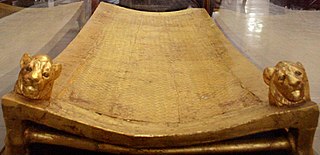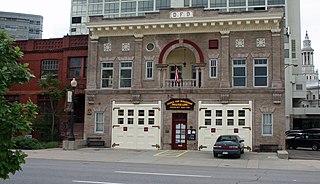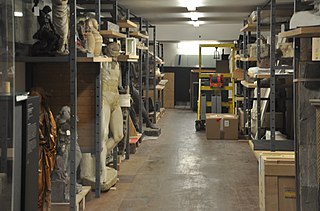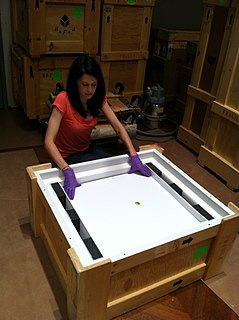
The Science Museum is a major museum on Exhibition Road in South Kensington, London. It was founded in 1857 and today is one of the city's major tourist attractions, attracting 3.3 million visitors annually.

The Royal Ontario Museum is a museum of art, world culture and natural history in Toronto, Ontario, Canada. It is one of the largest museums in North America and the largest in Canada. It attracts more than one million visitors every year, making the ROM the most-visited in Canada. The museum is north of Queen's Park, in the University of Toronto district, with its main entrance on Bloor Street West. The Museum subway station of the Toronto Transit Commission is named after the ROM and, since a 2008 renovation, is decorated to resemble the institution's collection.
The Peel Art Gallery, Museum and Archives (PAMA) is a museum, art gallery, and archives for the Regional Municipality of Peel and are located in Brampton, Ontario, Canada. Previously, it was the Peel Heritage Complex. Its facilities were originally the Peel County Courthouse, Brampton Jail, a land registry office, and a county administration building. It is opposite Gage Park and Brampton City Hall.

Canadian Forces Station Carp is a former Canadian military facility located in the rural farming community of Carp, Ontario, approximately 30 km (19 mi) west of downtown Ottawa.

Science Museum of Minnesota is an American museum focused on topics in technology, natural history, physical science, and mathematics education. Founded in 1907 and located in Saint Paul, Minnesota, the 501(c)(3) nonprofit institution is staffed by over 600 employees and over 1,600 volunteers. The museum's mission statement is to "Turn on the science: Inspire learning. Inform policy. Improve lives."
Star Wars: Where Science Meets Imagination is a traveling exhibition created by the Museum of Science, Boston, featuring props and costumes used in the Star Wars films, but focusing primarily on the science behind George Lucas' science fiction epic. Star Wars: Where Science Meets Imagination was developed by Boston's Museum of Science, in collaboration with Lucasfilm Ltd., with the support of the National Science Foundation, under Grant No. 0307875. This exhibit is presented nationally by Bose Corporation.

The Ann Arbor Hands-On Museum, located in Ann Arbor, Michigan, United States, specializes in interactive exhibits with the goal of helping both children and adults discover the scientist within them by promoting science literacy through experimentation, exploration, and education.

The Children's Museum of Indianapolis is the world's largest children's museum. It is located at 3000 North Meridian Street, Indianapolis, Indiana, United States, in the United Northwest Area neighborhood of the city. The museum is accredited by the American Alliance of Museums. It is 472,900 square feet (43,933.85 m2) with five floors of exhibit halls and receives more than one million visitors annually. Its collection of over 120,000 artifacts and exhibit items is divided into three domains: the American Collection, the Cultural World Collection, and the Natural World Collection. Among the exhibits are a simulated Cretaceous dinosaur habitat, a carousel, and a steam locomotive. The museum's focus is family learning; most exhibits are designed to be interactive, allowing children and families to actively participate.
The Anchorage Museum is a large art, history, ethnography, ecology and science museum located in a modern building in the heart of Anchorage, Alaska. It is dedicated to studying and exploring the land, peoples, art and history of Alaska.

The William R. and Clarice V. Spurlock Museum, better known as the Spurlock Museum, is an ethnographic museum at the University of Illinois at Urbana-Champaign. The Spurlock Museum's permanent collection includes portions of collections from other museums and units on the Urbana-Champaign campus such as cultural artifacts from the Museum of Natural History and Department of Anthropology as well as historic clothing from the Bevier Collection of the College of Agricultural, Consumer and Environmental Sciences. The Museum also holds objects donated by other institutions and private individuals. With approximately 51,000 objects in its artifact collection, the Spurlock Museum at the University of Illinois at Urbana-Champaign collects, preserves, documents, exhibits, and studies objects of cultural heritage. The Museum’s main galleries, highlighting the ancient Mediterranean, modern Africa, ancient Egypt, Mesopotamia, East Asia, Oceania, Europe, and the Americas, celebrate the diversity of cultures through time and across the globe.

An audio tour or audio guide provides a recorded spoken commentary, normally through a handheld device, to a visitor attraction such as a museum. They are also available for self-guided tours of outdoor locations, or as a part of an organised tour. It provides background, context, and information on the things being viewed. Audio guides are often in multilingual versions and can be made available in different ways. Some of the more elaborate tours may include original music and interviews. Traditionally rented on the spot, more recently downloaded from the Internet or available via the mobile phone network. Some audio guides are free or included in the entrance fee, others have to be purchased separately.

The National Museum of Scotland, Edinburgh, Scotland, was formed in 2006 with the merger of the new Museum of Scotland, with collections relating to Scottish antiquities, culture and history, and the adjacent Royal Museum, with collections covering science and technology, natural history, and world cultures. The two connected buildings stand beside each other on Chambers Street, by the intersection with the George IV Bridge, in central Edinburgh. The museum is part of National Museums Scotland. Admission is free.

The National Museum of Computing is a museum in the United Kingdom dedicated to collecting and restoring historic computer systems. The museum is based in rented premises at Bletchley Park in Milton Keynes, Buckinghamshire and opened in 2007. The building — Block H — was the first purpose-built computer centre in the world, hosting six Colossus computers by the end of World War II.

Exhibitions of artifacts from the tomb of Tutankhamun have been held at museums in several countries, notably the United Kingdom, Soviet Union, United States, Canada, Japan, and France.

The Denver Firefighters Museum is a museum in downtown Denver, Colorado, United States. A nonprofit institution 501 (C) (3), it consists of an 11,000-square-foot (1,000 m2) facility housing four galleries that explore the history of firefighting in Denver. Established in 1978, it is located in the 1909-built former Fire Station No. 1, a building that has been listed on the National Register of Historic Places since 1979.

The Uganda Museum is located in Kampala, Uganda. It displays and exhibits ethnological, natural-historical and traditional life collections of Uganda's cultural heritage. It was founded in 1908, after Governor George Wilson called for "all articles of interest" on Uganda to be procured. Among the collections in the Uganda Museum are playable musical instruments, hunting equipment, weaponry, archaeology and entomology.

An exhibition, in the most general sense, is an organised presentation and display of a selection of items. In practice, exhibitions usually occur within a cultural or educational setting such as a museum, art gallery, park, library, exhibition hall, or World's fairs. Exhibitions can include many things such as art in both major museums and smaller galleries, interpretive exhibitions, natural history museums and history museums, and also varieties such as more commercially focused exhibitions and trade fairs.

A collection manager ensures the proper care and preservation of objects within cultural institutions such as museums, libraries, and archives. Collection managers, along with registrars, curators, and conservators, play an important role in collections care. Collection Managers and Registrars are two distinct collection roles that are often combined into one within small to mid-size cultural institutions. Collection Managers can be found in large museums and those with a history and natural history focus whose diverse collections require experienced assessment to properly sort, catalog, and store artifacts. A collection manager may oversee the registrar, archivist, curator, photographer, or other collection professionals, and may assume the responsibilities of these roles in their absence within an organization.

An art handler, also sometimes called an art preparator, is a trained individual who works directly with objects in museums, art galleries and various other venues including private collectors, corporate art collections, public art collections and various other institutions. Art handlers work in coordination with registrars, collection managers, conservator-restorers, exhibition designers, and curators, among others, to ensure that objects are safely handled and cared for. Often they are responsible for packing and unpacking art, installing and deinstalling art in exhibitions, and moving art around the museum and storage spaces. They are an integral part of a museum and collections care.

A Conservation Technician is a specialist who is trained in basic conservation methods pertaining to cultural property and may work in museums or public or private conservation organizations. Typically an individual may work with or be subordinate to a conservator. A technician may also work in conjunction with other collection staff, such as a registrar (museum) or collection manager.




















